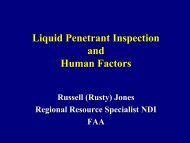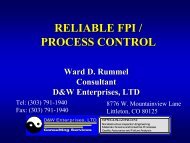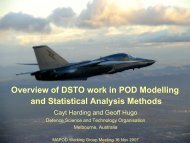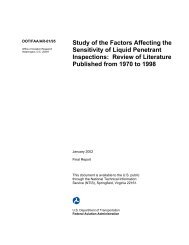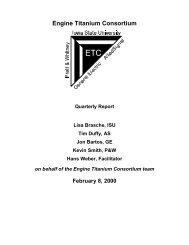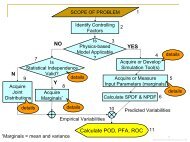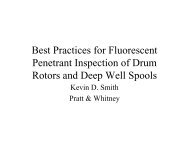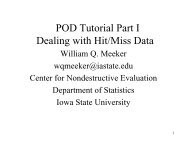Engine Titanium Consortium - Center for Nondestructive Evaluation ...
Engine Titanium Consortium - Center for Nondestructive Evaluation ...
Engine Titanium Consortium - Center for Nondestructive Evaluation ...
Create successful ePaper yourself
Turn your PDF publications into a flip-book with our unique Google optimized e-Paper software.
Objective/Approach Amendments: Objective and approach remain as originally proposed in July<br />
1998.<br />
Progress (January 1, 2002 – March 31, 2002):<br />
Several consortium conference calls were conducted during the quarter to discuss the details of the<br />
subtask. A number of technical issues were discussed and decisions reached. The technical<br />
issues and discussions are summarized into three primary areas, (1) Property Measurements, (2)<br />
Noise Curvature Blocks, and (3) Synthetic Inclusion Disk and discussed separately below.<br />
Property Measurements<br />
One goal of the Fundamental Studies subtask is to document the manner in which ultrasonic<br />
properties vary within representative Ti 6-4 <strong>for</strong>gings, and to relate those properties to the <strong>for</strong>ging<br />
microstructure. The ultrasonic data will then be used by Subtask 1.3.2 to design new <strong>for</strong>ging<br />
inspections which improve defect detection sensitivity four-fold: from the current #1 FBH level to a<br />
#1/2 FBH level. Since backscattered grain noise is primarily responsible <strong>for</strong> determining defect<br />
detection limits, the emphasis has been on grain noise measurement and analysis.<br />
The overall plan calls <strong>for</strong> UT measurements on coupons cut from selected sites in three typical Ti 6-<br />
4 <strong>for</strong>gings supplied by the OEMs. Approximately 8-10 coupons have now been cut from each<br />
<strong>for</strong>ging, with coupon sites chosen to provide a range of local microstructures (based on<br />
backscattered noise C-scan, macroetch, and strain-map data). In previous quarters, grain noise<br />
studies were concluded on suites of coupons cut from <strong>for</strong>ged disks provided by GE and P&W.<br />
During the Jan-Mar 2002 quarter, similar measurements were conducted on the coupons from the<br />
Honeywell (HW) <strong>for</strong>ging. The noise measurement and FBH normalization procedures were<br />
identical to those reported in the Jan-Mar 2001 Quarterly Report. The noise measurement setup is<br />
shown in Figure 1, together with the coupon sites <strong>for</strong> the HW <strong>for</strong>ging.<br />
Backscattered grain noise amplitudes <strong>for</strong> one case are shown in Figure 2. The noise C-scans <strong>for</strong><br />
the HW coupons generally showed little variation with position in the hoop direction; however in<br />
some cases there was a strong variation with inspection direction or with radial/axial position. As<br />
was done earlier, each coupon was divided into quadrants of approximately uni<strong>for</strong>m noise<br />
amplitude, and noise statistics <strong>for</strong> each quadrant were computed <strong>for</strong> the two inspection directions in<br />
the radial-axial plane. Gated-peak noise amplitudes were measured relative to an available #1<br />
FBH reference, namely a 0.5”-deep hole in an IN100 step block. ISU models were then used to<br />
rescale the noise data relative to a hypothetical #1 FBH in Ti 6-4 at the same average depth as the<br />
noise measurements. Resulting average and peak noise levels <strong>for</strong> the HW coupons are shown in<br />
Figure 3.<br />
Measured average and maximum gated-peak noise levels are compared <strong>for</strong> the three OEMsupplied<br />
<strong>for</strong>gings in Table 1. When averaged over all coupons and inspection directions, results <strong>for</strong><br />
the three <strong>for</strong>gings were quite similar. The largest peak noise level seen in all of the cases studied<br />
was 6.9% of the #1 FBH reference. This occurred within Honeywell coupon #5 which was located<br />
in the OD portion of the <strong>for</strong>ging, about midway between the “<strong>for</strong>ward” and “aft” surfaces.<br />
Quarterly Report – January 1, 2002 –March 31, 2002<br />
print date/time: 6/6/2002 - 8:39 AM – Page 36



